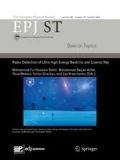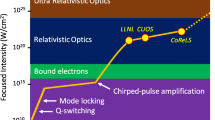Abstract
In the last decade or so, an evolution in experimental relativistic laser-plasma physics has led to highly sophisticated lasers which are now capable of generating ultra-short pulses and can be focused to intensities in excess of 1021 W cm-2. The laser interaction with solid or gas targets can generate collimated beams of highly energetic electrons, protons and ions. These high-intensity laser systems, therefore, turn out to be versatile and powerful sources of radiation and high-energy particles, without recourse to large-scale facilities such as nuclear reactors or particle accelerators. The potential to induce various kinds of nuclear reactions with laser-induced radiation fields has been demonstrated at several laboratories in recent years. The present paper lays out a comprehensive overview of nuclear reactions induced by high-intensity laser matter interactions. Mechanisms for electron, proton and ion acceleration, in addition to secondary bremsstrahlung, positron and neutron production, are addressed, with a focus on the types of nuclear reactions that are possible and potential applications. Discussion of the extrapolation of these processes and applications to the next generation of table-top lasers under construction is also presented.
Similar content being viewed by others
References
M.J. Feldman, R.Y. Chiao, Phys. Rev. A 4, 352 (1971)
C.K. Rhodes, Science 264, 1345 (1985)
J.E. Lynn, Nature 333, 116 (1988)
K. Boyer, et al., Phys. Rev. Lett. 60, 557 (1988)
K.W.D. Ledingham, et al., Phys. Rev. Lett. 84, 899 (2000)
T.E. Cowan, et al., Phys. Rev. Lett. 84, 903 (2000)
D. Umstadter, Nature 404, 239 (2000)
H. Schwoerer, et al., Europhys. Lett. 61, 47 (2003)
G. Malka, et al., Phys. Rev. E 66, 66402 (2002)
J. Magill, et al., Appl. Phys. B 77, 387 (2003)
K.W.D. Ledingham, et al., J. Phys. D 36, L79 (2003)
F. Ewald, et al., Plasma Phys. Control. Fusion 45, 1 (2003)
A. Modena, et al., Nature 377, 606 (1995)
V. Malka, et al., Science 298, 1596 (2002)
Z. Najmudin, et al., Phys. Plasma 10, 2071 (2003)
J. Faure, et al., Nature 431, 541 (2004)
S.P.D. Mangles, et al., Nature 431, 535 (2004)
J. Galy, et al., New J. Phys. 9, 23 (2007)
T.E. Cowan, et al., Nucl. Instr. Meth. Phys. Res. A 455, 130 (2000)
R.A. Snavely, et al., Phys. Rev. Lett. 85, 2945 (2000)
A.P.L. Robinson, et al., Phys. Rev. Lett. 96, 35005 (2006)
P. McKenna, et al., Phys. Rev. Lett. 94, 1 (2005)
L. Robson, et al., Lect. Notes Phys. 694, 191 (2006)
P. McKenna, et al., Phys. Rev. Lett. 91, 075006 (2003)
E.L. Clark, et al., Phys. Rev. Lett. 85, 1654 (2000)
M. Hegelich, et al., Phys. Rev. Lett. 89, 085002 (2002)
M. Zepf, et al., Phys. Rev. Lett. 90, 064801 (2003)
T. Zagar, et al., New J. Phys. 7, 1 (2005)
J. Yang, et al., J. Appl. Phys. 96, 6912 (2004)
K.L. Lancaster, et al., Phys. Plasmas 11, 3404 (2004)
Author information
Authors and Affiliations
Corresponding author
Rights and permissions
About this article
Cite this article
Galy, J., Hamilton, D. & Normand, C. High-intensity lasers as radiation sources. Eur. Phys. J. Spec. Top. 175, 147–152 (2009). https://doi.org/10.1140/epjst/e2009-01133-4
Published:
Issue Date:
DOI: https://doi.org/10.1140/epjst/e2009-01133-4




